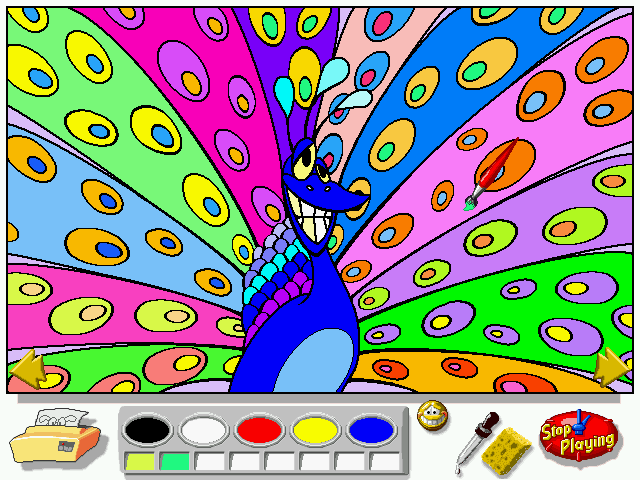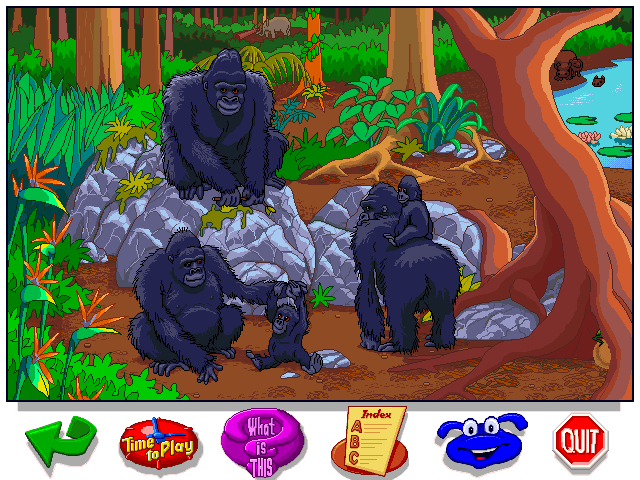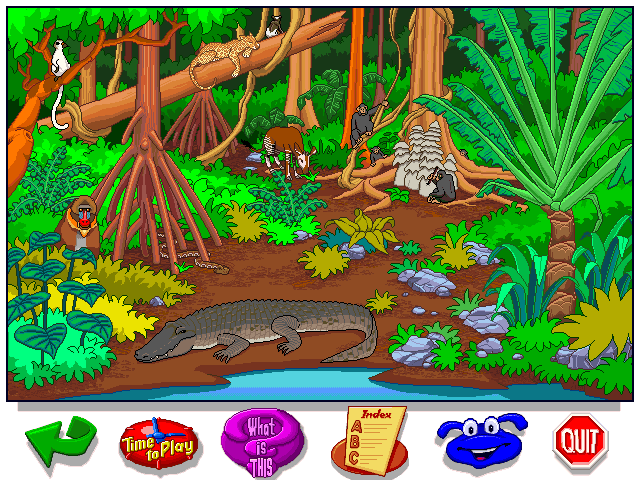Retro Replay Review
Gameplay
Let’s Explore the Jungle encourages young players to embark on an interactive expedition through three vibrant, oversized versions of South American, African, and Southeast Asian jungles. Children guide their avatar around multiple distinct locations, such as winding riverbanks, dense canopies, and hidden clearings. Clicking on plants, animals, or artifacts triggers delightful animations, from a playful troop of monkeys swinging in the vines to a camouflaged frog leaping into view.
Central to the experience is Buzzy the Knowledge Bug, a friendly guide who reads aloud questions, answers, and object names. Buzzy’s voice narration keeps children engaged—he offers helpful tips, poses trivia prompts, and shares fascinating tidbits about each species. When a curious player asks “What is this?”, Buzzy whisks them away to a micro-encyclopedia entry that provides both visual and audio descriptions, reinforcing both reading and listening skills.
Beyond free exploration, Let’s Explore the Jungle features five mini-games designed to reinforce knowledge through play. Trivia quizzes challenge kids to recall facts they’ve encountered, while the “Find It” game displays images of jungle inhabitants and tasks them with locating those creatures in the environment. Jungle Jumble tests spelling with scrambled words, and the colorful 15-page digital coloring book allows players to mix and match hues before printing their masterpieces.
For those seeking an arcade twist, the Anteater Feeder mini-game delivers fast-paced fun. Using an anteater’s tongue as the “weapon,” kids gobble virtual bugs in a 100-level carnival style challenge. Difficulty settings across all mini-games let parents tailor the experience to individual skills, ensuring that novice explorers feel confident and more advanced learners remain intrigued.
Graphics
The visual presentation in Let’s Explore the Jungle is bright and cartoony, perfectly suited for its target audience of early readers and young explorers. Each jungle environment bursts with lush greenery, dynamic weather effects like drifting mist and sun-dappled clearings, and a rich color palette that captures the diversity of real-world ecosystems. Close-up animations—such as a butterfly fluttering around a flower or a crocodile yawning by the river—add delightful touches of realism.
Character and creature designs are charmingly stylized, balancing educational clarity with playful appeal. Buzzy the Knowledge Bug is rendered in crisp, friendly lines, making his on-screen appearances instantly recognizable. Animals and plants are drawn with enough botanical or zoological detail to be informative, but their exaggerated expressions and movements keep the mood light and engaging.
The interface makes excellent use of visual cues. Interactive hotspots gently pulse or glow, guiding children’s attention without overwhelming them. Encyclopedia pages combine high-resolution photographs, hand-drawn illustrations, and colored hyperlinked words that hint at related topics. Transitions between exploration and encyclopedia entries are smooth, with minimal loading times to maintain immersion.
Story
Let’s Explore the Jungle doesn’t revolve around a conventional narrative arc but rather builds a cohesive educational journey. The implicit story is that of a budding naturalist accompanied by Buzzy the Knowledge Bug, traveling through untamed wilds to uncover secrets of exotic flora and fauna. This open-ended structure encourages self-directed discovery and empowers children to craft their own adventure based on personal curiosity.
Moments of discovery—like stumbling upon a hidden orchid grove or witnessing a chameleon change color—serve as narrative beats that sustain excitement. Buzzy’s occasional guidance frames these discoveries, offering context and prompting players to delve deeper. This structure blends the freedom of sandbox play with the satisfaction of unlocking new facts, creating a learning narrative that feels both organic and purposeful.
Though there is no villain to vanquish or treasure to unearth, the game’s underlying theme of exploration provides a gentle sense of achievement. Each encyclopedia entry “unlocked” becomes a milestone, motivating kids to keep exploring until all 210 items are found. This cumulative approach to story ensures that players feel a real sense of progression as their personal jungle knowledge expands.
Overall Experience
Let’s Explore the Jungle succeeds as an educational adventure that balances learning with lighthearted fun. The blend of free-roam exploration, interactive animations, and fact-filled encyclopedia entries offers a rich, multifaceted experience. Children not only encounter the sights and sounds of exotic jungles, but they also absorb scientific details through both text and narration, reinforcing literacy and listening comprehension.
The inclusion of varied mini-games adds replay value and caters to different learning styles—whether a child prefers quizzes, hidden-object challenges, spelling puzzles, or creative coloring. Difficulty settings across these activities mean that both younger players and more advanced learners can find the right level of challenge. Parents and educators will appreciate this adaptability, as well as the printable coloring pages that bridge digital play and hands-on creativity.
While the game’s graphics and user interface are child-friendly, older siblings or parents may find the design simplistic if they’re seeking a deeper narrative or more complex mechanics. However, for its intended audience of early elementary learners, Let’s Explore the Jungle offers a robust package of discovery and delight. With its friendly guide, vivid landscapes, and well-curated content, this title stands out as an engaging educational tool that invites repeated exploration.
Overall, Let’s Explore the Jungle is a thoughtfully crafted edutainment title that will captivate curious minds. It encourages exploration at a child’s own pace, fosters connections between visual, auditory, and textual learning, and rewards discovery with fun animations and mini-game challenges. It’s a strong choice for families and classrooms seeking an interactive way to bring the wonders of the world’s jungles into their learning environment.
 Retro Replay Retro Replay gaming reviews, news, emulation, geek stuff and more!
Retro Replay Retro Replay gaming reviews, news, emulation, geek stuff and more!









Reviews
There are no reviews yet.